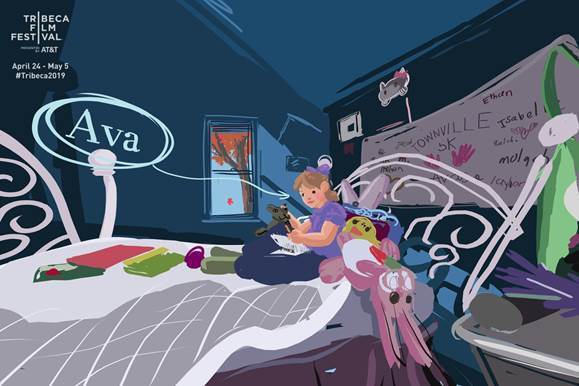The film is dreamy, whimsical, childlike.
A little boy on a swing set. A little girl in her bedroom, writing a letter asking the boy to come over and play. Her cat stretches out next to her.
Then it becomes heartbreaking as you learn the children are based on real people and that the little boy is now dead. He was first-grader Jacob Hall, shot and killed in 2016 when a 14-year-old opened fire during recess at Townville Elementary School in South Carolina. The little girl is Ava Olsen. Jacob was her best friend.
The immersive 360-degree film “12 Seconds of Gunfire: The True Story of a School Shooting,” produced by the Washington Post, is ambitious, risky and, ultimately, powerful experimental storytelling to describe what Ava has gone through since that horrible day.
“We wanted to do something where the act of being immersed in it makes the story richer and more compelling than it would be any other way,” Jeremy Gilbert, the Post’s director of strategic initiatives, told Poynter on Monday.
The film is meant to be seen with virtual reality goggles, but the Post released a theatrical version Monday. Both take you inside Ava’s world.
So where did this delicate idea come from?
In 2016, Gilbert’s team did a virtual reality piece that took users on an interactive journey through Mars. The Post was looking for another experimental way to use 360-degree VR as a way to tell a story. So Post design editor Suzette Moyer, senior developer Seth Blanchard and Gilbert began to search for a topic that would lend itself to the alternate story form.
They found it in Post staff writer John Woodrow Cox’s “Twelve Seconds of Gunfire,” which was a 2018 Pulitzer Prize finalist in Feature Writing. Cox profiled four first-graders deeply impacted by the shootings. For this project, the Post chose to tell Ava’s story.
“Probably a heavier story than we all anticipated,” Moyer said.
Maybe too heavy? Didn’t the Post worry that it was too sensitive to tell in illustration form?
“This is a story that mostly is about understanding what is in Ava’s head,” Gilbert said. “She’s a survivor of trauma, but it’s not the physical stage. It’s rather the feelings she is wrestling with that John so masterfully conveyed. So the idea of us illustrating the piece had to be about that. We would never want to recreate the details of the shooting itself.”
Ava’s family gave its approval and the Post, using Ava’s actual spoken and written words, explored ways to portray what was going on inside the head of a 6-year-old. Moyer remembered a virtual reality film she had seen called “Dear Angelica,” about a little girl who lost her actress mother at a young age and reconnects with her by watching old films on a VCR. Moyer reached out to artist of “Dear Angelica,” Wesley Allsbrook, who agreed to take on her first editorial project.
Cox wrote the script while Allsbrook worked on storyboards. Moyer said the script was revised at least a dozen times before Allsbrook was tasked with drawing the final version, which resulted in a compelling 8-minute, 20-second film. A voice actor plays Ava.
The film starts with Jacob playing on a swing set, then switches to Ava writing letters to Jacob from her bedroom. All the scenes, Moyer said, were based on actual events and photos of the real places. The shooting is handled with the audio of the 911 call.
“We tried to depict (the shooting) in a way that (viewers) didn’t feel super uncomfortable,” Moyer said. “But this is really about how she deals with the aftermath of the shooting.”
That aftermath includes Ava learning Jacob has died, Jacob wearing a Batman costume in a casket and, later, Ava answering questions from a doctor, who diagnoses her as having post-traumatic stress disorder. That’s where the film was supposed to end.
But it was Ava who kept the story going by writing a letter to President Donald Trump about the shooting and asking him to make schools safe and protect children. The president responded with a touching letter back to Ava.
The film ends with Ava’s sobering reaction to Trump’s letter and, for the first time in the film, actual photos of Ava and Jacob, side-by-side.
In the end, it’s a different kind of telling of an all-too-familiar story, and the result is an effective piece of journalism. Moyer said Ava’s mother reached out the Post on Monday, complimenting the film and thanking the Post for giving Ava a voice. Cox, meantime, is working on a book about Ava that’s due out next year.
And the Post continues experimenting.
“We are always looking for new ways,” Gilbert said, “to bring stories to life for our readers.”







